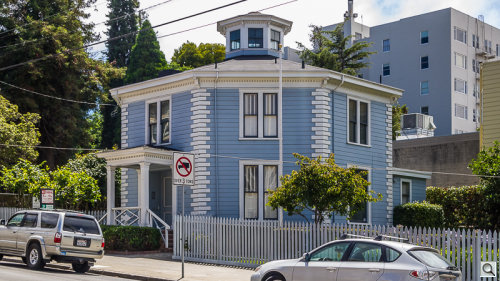Photo Corners headlinesarchivemikepasini.com
![]()
A S C R A P B O O K O F S O L U T I O N S F O R T H E P H O T O G R A P H E R
![]()
Enhancing the enjoyment of taking pictures with news that matters, features that entertain and images that delight. Published frequently.
Friday Slide Show: The Octagon House




5 August 2016
Whether it's the Palace of Fine Arts or the Octagon House or the rusted gutters on our own domicile in the city, it's reassuring to know that every great structure around here has been threatened with demise only to be rescued by the people who loved the place.
Demise comes to us all, naturally. Resistance is futile. But meanwhile we can tell the band what to play.
Octagon houses were the Eichlers of their day, which would have been the 1850s (when civil wars were fought outside the home).
They were the modern plan. More efficiently heated in winter and cooler in the summer. More natural light than any square structure. Eight sides to the world, they were the bright idea of amateur architect and lifestyle pundit Orson Squire Fowler.
There are two of them in San Francisco. The other one is the more ornate Feusier Octagon House built in 1858.
'... each November 24 something may be heard climbing the stairs to the second floor. At the 20th step, the something lets out a piercing shriek.'
This one was built in 1861 but it only took a few generations to forget all about who built it and who lived in it, obliging a local publication to guess rather accurately it had been built between 1848 and 1864 and, rather inaccurately, that "on the night of each November 24 something may be heard climbing the stairs to the second floor. At the 20th step, the something lets out a piercing shriek. This is followed by a muffled thumping, as of a body falling down the 20 steps to the first floor landing. Then there is silence."
So how do we know it was built in 1861? We know thanks to an electrician.
In March 1953 he was installing a new outlet in the place when he found a two-pound time capsule hidden by the original owners in a wall near the stairs leading to the cupola.
William Carroll McElroy and his wife Harriet Shober McElroy had stuffed the tin with newspapers and an ambrotype of the whole family with a letter written by McElroy confirming they built the place as their "privet Residence."
The electrician was part of the team saving the old place lead by two sisters, Edith and Lucy Allyne, who had it moved across the street for The National Society of The Colonial Dames of America in California to house historical documents previously held by the de Young Museum. Small world.
It's open to the public at no charge from noon to 3 p.m. on the second Sunday and second and fourth Thursday of each month except January. Got that? You'll find it at 2645 Gough St. at Union St.
We were obliged to admire it from a distance, having arrived, to our demise, on the first Sunday of the month.
But what better way to admire its eight sides than from outside?
